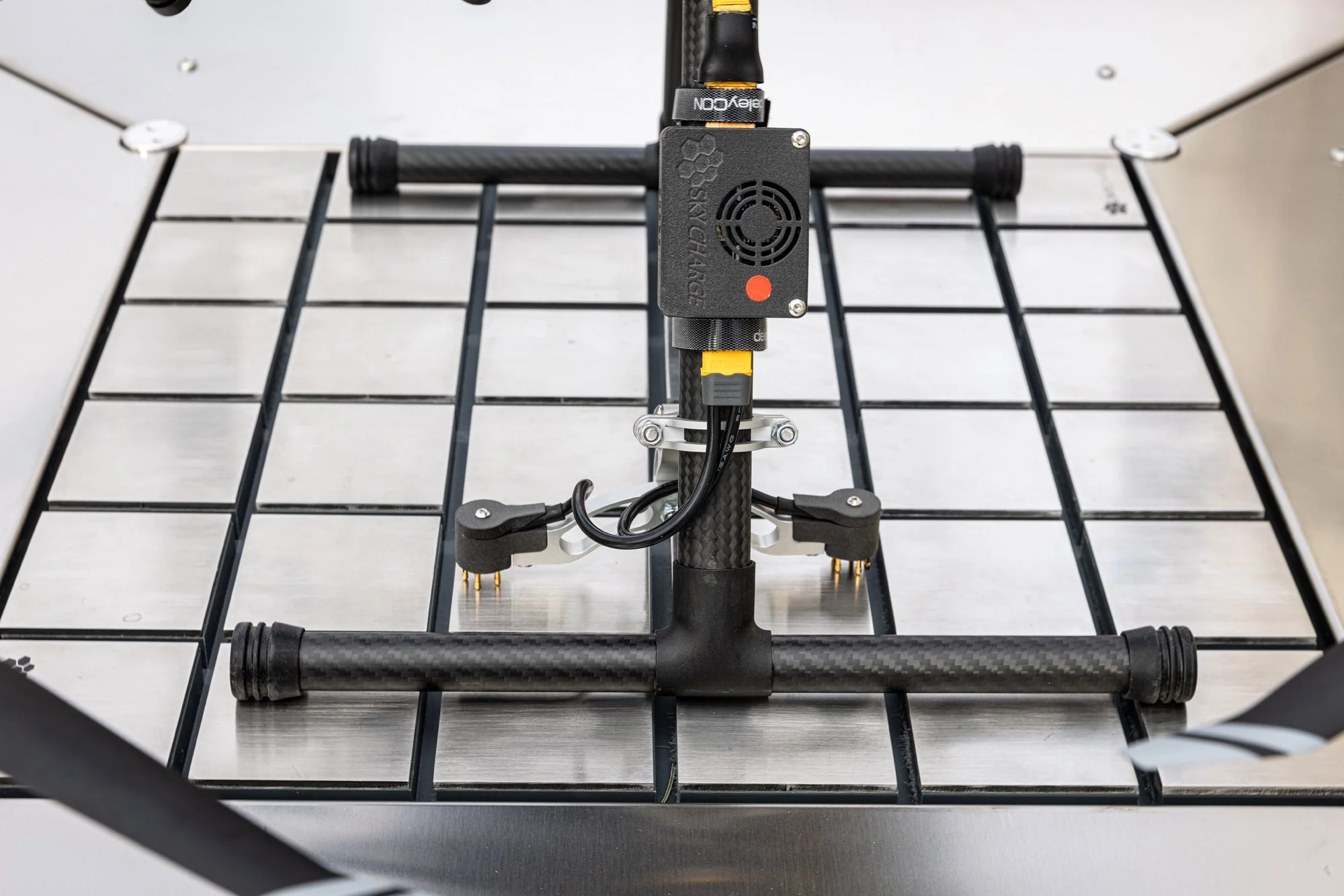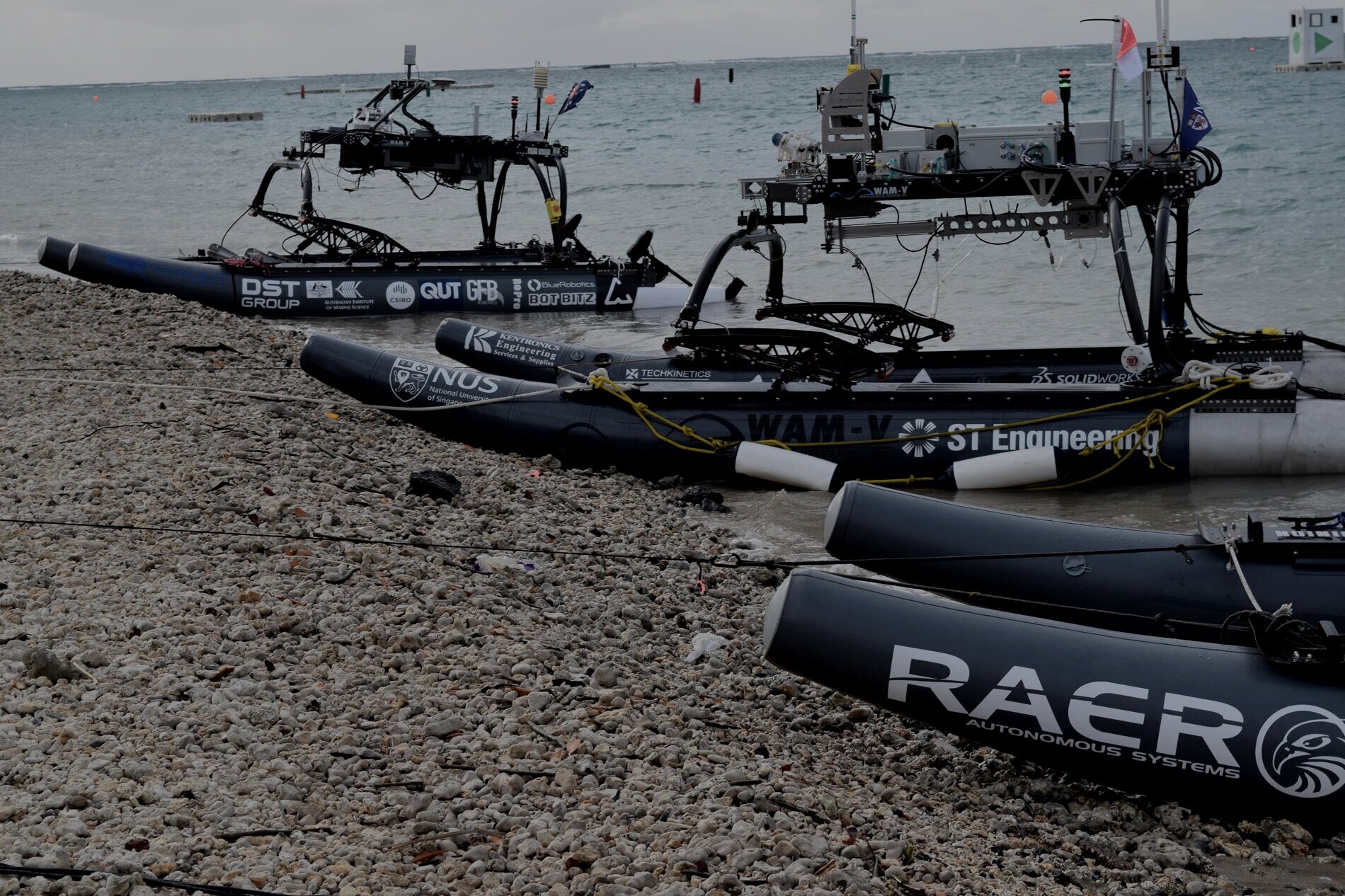
Autonomous smart charging and docking for your UAV fleet
Contact-based system enables drones to self-charge efficiently
Introducing Skycharge's proprietary autonomous smart charging solution designed specifically for commercial drones (UAVs).
The Skycharge system seamlessly blends the reliability and efficiency of wired charging with the convenience of wireless technology. By dynamically adjusting voltage and current, it ensures optimal charging for any battery, tailored to your specific needs.
The benefits are clear: enhanced safety, robust power management, extended battery lifespans, cross-platform, and, ultimately, improved returns on investment for your drone and charging station fleet. Skycharge, powers your drones smarter, safer, and more efficiently than ever before.
The charging technology
The Skycharge charge system has two key elements: the Source and the Sink. The Source delivers power to the Sink, which is, in turn, typically connected to a battery.
The Sink comes pre-configured with voltage and current settings corresponding to the specifications of the battery to be charged. When a Sink is connected to a Source, the Source reads the Sink configuration and adjusts the current and voltage settings accordingly.
You can also customize the Sink’s configuration – to optimize a drone’s power management based on its usage, for example. Why not have certain drones charging slower during the night (and faster during the daytime) to extend battery lifespan? During the charging process, the Source and the Sink communicate this information via the power line. Any other data you want to transport can also flow in both directions, without any radio emission.
The docking systems
In the Skycharge development kit, you’ll find the Source unit, connected to two inox steel conductive tiles, and the Sink, which is connected to a contact unit. The contact unit has been designed to be easily mounted/installed on any drone/robot. The tiles are usually fixed on a flat horizontal/vertical surface, while the contact unit is mounted on the drone landing gear/robot frame. When the spring-loaded contacts come into physical contact with the conductive tiles, the charging process can begin.
The Skycharge system is engineered to integrate with any charging contacts, so you can build your own, or integrate a third-party solution.
The software platform
Getting started with Skycharge is made simple, thanks to our free and intuitive cloud dashboard, which enables you to configure, manage, and monitor your systems all in one place. This is just the tip of the iceberg, however. Our software development kit (SDK) is open source and published under the BSD-3 license. The code and the tools are available on GitHub.
The Skycharge SDK is a framework for developing charging services and applications. It enables developers to create applications to control the charge system directly, both from the cloud and on-premises. All the charge system parameters (voltage, current, power, charge, energy, etc.) are accessible through an easy-to-use and fully documented API.
Implementation scenarios
Skycharge can be integrated with a variety of drones and robots.
Implementation for automatic UAV charging pad
Implementation for automatic UGV charging station
Implementation for automatic battery charging

“I would like to thank Skycharge for the exceptional customer service provided. Your customer support was extremely helpful in answering many questions we had while integrating the drone charging pad into our system. Your detailed answers saved us numerous man-hours of investigation and testing. It’s refreshing to see there are still companies that understand the importance of quality customer support. Yours is first-rate.”
— Ed Henderson, Sr. Engineer, Florida Atlantic University, SeaTech – The Institute for Ocean & Systems Engineering
Get the development kit
Would you like to test out how Skycharge works with your drone/robot? Maybe you’ve developed your own contact system, and just need a programmable charging system that doesn’t expose the battery voltage? Some hands-on time with the development kit will help you answer any questions you might have, and see how Skycharge’s system works. If you then decide you only want to buy the bare electronics – to integrate with other third-party components – that’s also possible.
The Skycharge development kit comes pre-assembled and pre-configured for your battery. It includes all the necessary components and documentation to ensure a successful implementation – and you can always email us with any unexpected queries.
Superior proprietary Technology
SYSTEM |
Footprint |
Weight |
Contact detection |
Programmability level |
Open source |
Efficiency |
Cost |
|---|---|---|---|---|---|---|---|
Skycharge |
Smallest |
Smallest |
Yes |
Highest |
Yes |
High |
Low |
Wireless charging |
High |
High |
Yes |
High |
No |
Poor |
High |
Contact charging |
Small |
Small |
No |
Low |
No |
High |
Low |
Most robots and drones use simple electrical contacts to charge. They are small, light, reliable, efficient, cheap, and easy to integrate. Wireless charging, on the other hand, is bulky, heavy, more complex, and more expensive. Wireless systems also can’t compete on capacity with physically connected charging contacts. The Skycharge system has all the positive aspects of contact charging, but adds redundant protections against shorts and battery failures, a unique feature set, and an open-source software stack – making it unlike any other charge system on the market.
Redundant safety
The contact unit can safely come into contact with any conductive surface and liquids without generating a short – so if your drone needs to make an emergency landing on a wet floor or a metal roof it can do so safely. The Skycharge system also comes with robust protections against overload, over voltage, and over temperature.
1. SCANNING
The Source scans for a Sink connected to the output contacts. During the scanning process, low voltage with limited current is applied.
2. LINK ESTABLISHED
When physical contact is established, the Source and the Sink start communicating over the power line. The Sink transmits the charging parameters to the Source, as well as any other customer data.
3. PRE-CHARGE DELAY
The Source waits for a pre-defined delay before charging, to help ensure battery safety. This pre-charge delay can be specified by the user.
4. PRE-CHARGING
Pre-charging starts with a low current that is gently increased. The pre-charging values (current start and time) can be specified by the user.
5. CHARGING
The charging process starts, based on either the Sink’s or the Source’s charging parameters. Once the battery reaches your desired state of charge, charging ends. You can also implement your own charging logic and algorithm to suit your needs.
Charging management and monitoring
Our free, intuitive, web-based dashboard makes getting started with Skycharge simple. All parameters – including output voltage, output current and charging methodology – are easily configured. With visual representations of every charge session, you’ll have all the granular information you need to analyze your drone-/robot-charging habits. Skycharge also comes with a robust SDK for scalable on-premises and cloud implementations.
Open source and transparent
Skycharge SDK is open source and published under the BSD-3 license for developers to create their own closed applications and services. Besides all charging parameters, Skycharge’s hardware provides a unique data link that opens up near limitless possibilities for new developments and integrations with other hardware and software solutions.
When a Source is connected to a Sink, a data link is established alongside the electrical connection. No other charging system on the market has this feature. The data link is reliably established through the electrical connection, without radio emissions, and used by the charging system to optimize charging according to the battery’s needs.
But there are many other ways the data link could be used. You could use it to transfer BMS data, or to authorize a device before charging it. Maybe you want to charge different batteries in different ways, and dynamically adapt the charging curve based on BMS data – or build deep-learning-based charging algorithms and services. We look forward to hearing all about the innovative ways you put it to use!
Integrates with any docking solution
-
Integration with two contacts
Skycharge’s two-part development kit is simple to set up. Place the two conductive tiles on a flat surface, and mount the contact unit to your drone/robot. When these two elements connect, charging – and data transfer – begin. You can also connect Skycharge hardware to your own conductive tiles, platforms, and third-party charging contacts.
-

Integration with multiple contacts
One of the key limitations of contact/wireless charging is the maximum allowed displacement of the contacts/coils. With Skycharge, that problem is eradicated: you can build platforms as large as you like, by arranging several conductive tiles in a matrix. Our Bolognini S1 charging platform, for example, can charge drones of different sizes, and accommodate inaccurate landings too.
FAQs
-
Charging time is limited by the battery charging rate and the system’s maximum current output. Put simply, it takes about one hour to charge one 5,000mAh at 5Ah (1C), or 30 minutes to charge it at 10Ah (2C). Please check with the battery manufacturer what the maximum allowed charging rate for your batteries is.
-
During the scanning state, the system outputs 12 VDC. During the charging state, the system outputs up to 57 VDC, depending on your configuration. In either case, the DC voltage is low and not harmful – and hence the contacts are safe to touch.
-
During the scanning state, low voltage is applied with limited current. If a short is identified, the system deactivates the shorted contacts (only) until the condition is removed. During the charging process three safety systems are triggered in case of a short:
1. The power supply automatically limits current
2. The Sink fuse breaks when the current reaches the system’s maximum current output threshold
3. The Source identifies the short and stops the charging process.
-
The system supports any type of battery between 3S and 12S (11 VDC to 57 VDC).
-
Yes, although the system must be configured to provide the right voltage and current. With smart batteries, which have an embedded charge-balancing circuit (such as DJI batteries), each battery is connected to the Sink and will charge independently.
-
Yes. Although the Skycharge development kit comes with a ready-to-use contact solution ready for integration, you are free to connect your own contact system.
















